Hello friends,
This month, I am sharing some of the Canadian visual artists whose works should (in my humble opinion) be better known. To date, I have published notes on Inuk artist Kenojuak Ashevak, (ᕿᓐᓄᐊᔪᐊᖅ ᐋᓯᕙᒃ, Qinnuajuaq Aasivak), Emily Carr, Jean-Phillipe Daillare, Susan Edgerly, and Lauren Grace Fox. I also published two posts featuring the 10 women associated with the Beaver Hall Group, all of whom were influenced by celebrated modernist painter William Brymner.
This weekend, I am releasing two posts that focus on the influential Group of Seven, initially known as the Algonquin Group. Unlike the Beaver Hall Group, which was a loose configuration of artists, the Group of Seven had what they called a “like vision” and a shared focus on developing a distinctly Canadian style of painting through direct contact with nature.
With simple yet dynamic forms, vibrant colours, and tactile paint handling techniques, the Group of Seven inspired subsequent generations of Canadian artists. At the same time, the group’s movement of land-based nationalism erased Indigenous peoples from the landscape and perpetuated colonial myths about Canada that ignored Indigenous history and sovereignty.
Today, I’m sharing links and images from five of the artists. (Watch for a follow-up email featuring the work of the remaining five on Sunday, May 11.) I hope you will take a few minutes to meet the Group of Seven or, at least, view some of their incredible artwork. Then consider how we might look at their paintings in a new way.
Franklin Carmichael, the youngest original member of the Group of Seven, was inspired by theosophy and the teachings of Helena Blavatsky, who believed Canada would play a critical role in the dawn of a “spiritual, cultural, and aesthetic renaissance.” This notion appealed to the strong sense of “land-based nationalism” championed by the Group of Seven and, in particular, Carmichael.
Shown below: Mirror Lake.
Lawren Harris was a leading landscape painter inspired to create art that expressed spiritual, theosophical values as it represented the visible world. He espoused the belief that “art is the beginning of vision into the realm of eternal life.”
Shown below: Mountain Forms.
A.Y. Jackson is known for painting some of the most remote regions of Canada, especially in winter. He favoured simple, curving lines and mild colours, yet his works are strong and enduring.
Shown below: Aurora.
Frank Johnston wrote of the Group of Seven’s land-based nationalism: “It took us out into the open air to look at Canadian landscape as distinct from European landscape. It necessarily meant that each was free to look at the landscape which attracted him...”
Shown below: A Rocky Corner — Bryce’s Island, Lake of the Woods
Arthur Lismer, a renowned painter and influential art educator, was a powerful expressionist. His landscape paintings are characterized by his use of compressed simple forms and raw colour, which he applied to the canvas with coarse brushstrokes, resulting in paintings that were layered and thickly textured.
Shown below: Bright Land.
Tomorrow, the introduction to the Group of Seven continues with a look at the works of J. E. H. MacDonald, Frederick Varley, A. J. Casson, Edwin Holgate, and Lionel LeMoine FitzGerald. Please join me.
Sift.
Learn more about the Group of Seven and land-based nationalism.
There is no shortage of books, both popular and scholarly, about the Group of Seven. Several of the artists were, themselves, prolific writers. Here is one recommendation for your #tbr list.
A Like Vision: The Group of Seven and Tom Thomson (Ian A. C. Dejardin, Editor; Sarah Milroy, Goose Lane Editions, 2020)
Shift.
Question the colonial foundations of the Group of Seven’s land-based nationalism.
I love the Group of Seven’s iconic images, but I struggle against the inherent colonialism, and erasure of Indigenous history and sovereignty, in its assertion of land-based nationalism. Something Matteo Cimellaro articulates well:
It has taken me a long time to reconcile the Group of Seven and their place in Canada's mythology. On one hand, I love their paintings: they are beautiful and varied in their landscapes, a representation of these lands in all their sacredness and life. On the other hand, they suffocate. The Group of Seven's nationalist story surrounds us like the prints of their work that hang in Canada's households, schools, and galleries.
We are told to see their paintings — an essential chapter in our national story — as fundamentally Canadian. But the histories of Indigenous people on these lands, and the sacred and sovereign relationship we have with this land, are not reflected in the works of the Group or their peer and influence Tom Thomson.
You can read Cimellaro’s essay on the CBC Arts website:
“Let's liberate the Canadian landscape from the Group of Seven and their nationalist mythmaking” (Matteo Cimellaro, CBC Arts, April 8, 2022)
As well, I encourage you to learn about the Indigenous Group of Seven: Jackson Beardy (Cree), Eddy Cobiness (Ojibway), Alex Janvier (Dene, Saulteaux), Norval Morrisseau (Ojibway), Daphne Odjig (Potawatomi, Odawa), Carl Ray (Cree), and Joseph Sanchez (Pueblo, Spanish, German). (Subjects of a future post.)
“The Indigenous Group of Seven” (Erica Commanda, Muskrat Magazine, September 2, 2015)
Lift.
Take action by learning how to decolonize art.
In his essay for CBC Arts, Cimellaro challenges readers “to reject the colonial gaze: to see things as they are, blemished by the cruelty of history.” Interested in learning how to decolonize art? Check out the links below.
“Decolonization through the Art of Robert Houle: Teacher Resource Guide” (Art Canada Institute)
Before you go
Would you do me a small favour? If you enjoy reading Sift. Shift. Lift. please take a moment to like, share, or comment below. Thank you.


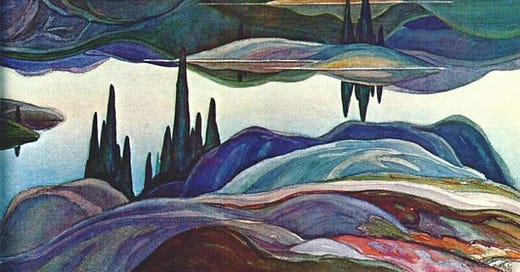



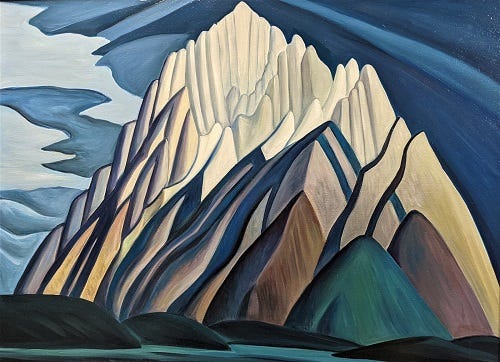
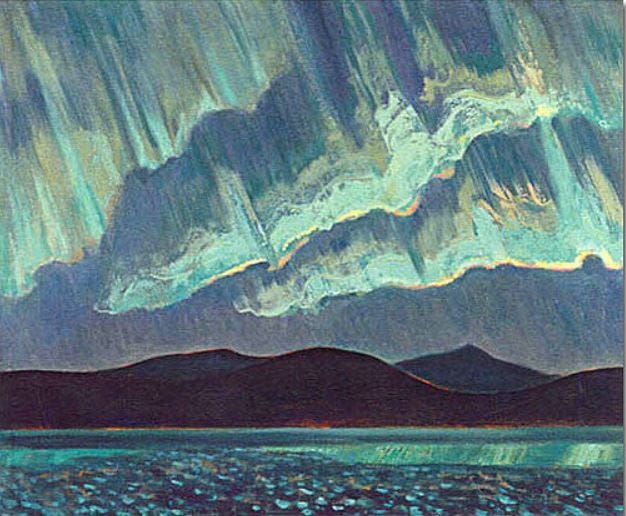
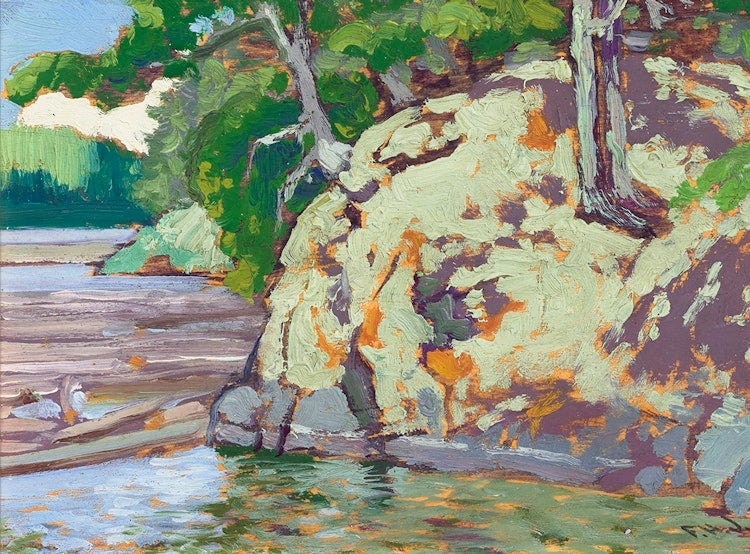
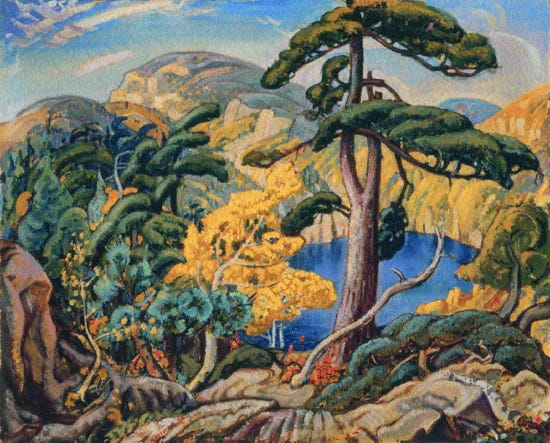
Reminds me of O’Keefe? Colors are incredible. Appropriate ahead of G7 summit in Canada. Thank you!
Gorgeous! Love these!